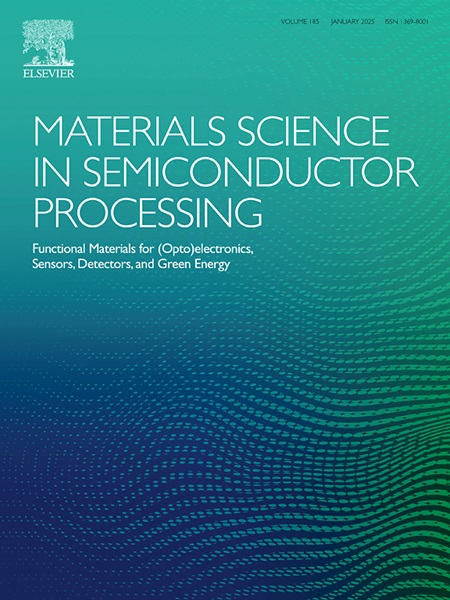inp波导平面InGaAs Gunn二极管的增强发光特性
IF 4.2
3区 工程技术
Q2 ENGINEERING, ELECTRICAL & ELECTRONIC
引用次数: 0
摘要
我们提出了一种基于n型In0.53Ga0.47As的Gunn发光二极管,在室温下脉冲工作,工作在约1620 nm,通过集成InP波导结构获得增强的发射特性。该器件包括一个5000nm厚的n型In0.53Ga0.47As薄膜,通过金属有机气相外延生长在半绝缘的InP衬底上。在约2.85 kV/cm的电场下,观察到周期约为0.2 ns的Gunn振荡。在1620 nm左右的波长处,光发射开始与电流-电压曲线上的负差分电阻阈值一致,并且随着外加电场的增加,发射强度显著增加。集成基于inp的光波导显著改善了器件的发射特性。虽然NDR的阈值电场和光发射保持不变,但与没有波导的参考器件相比,发射强度增加了6倍,这与仿真结果一致。这些发现揭示了InP波导集成在改善基于In0.53Ga0.47As的脉冲近红外发光Gunn器件性能方面的潜力。本文章由计算机程序翻译,如有差异,请以英文原文为准。
Enhanced light emission characteristic of an InP-waveguided planar InGaAs Gunn diode
We present a Gunn light-emitting diode based on n-type In0.53Ga0.47As, operating at approximately 1620 nm with enhanced emission properties achieved by integrating an InP waveguide structure, under pulsed operation at room temperature. The device comprises of a 5000 nm thick n-type In0.53Ga0.47As epilayer grown on a semi-insulating InP substrate via Metal Organic Vapor Phase Epitaxy. Gunn oscillations, with a period of approximately 0.2 ns, are observed at an electric field of approximately 2.85 kV/cm. The onset of light emission at a wavelength of around 1620 nm coincides with the Negative Differential Resistance threshold on the current-voltage curve, and the emission intensity markedly increases as applied electric field Increases. The integration of an InP-based optical waveguide significantly improves the emission characteristics of the device. Although the threshold electric field for NDR and light emission remains constant, the emission intensity increases sixfold compared to a reference device without a waveguide, which is consistent with the simulation results. These findings reveal the potential of InP waveguide integration in improving the performance of In0.53Ga0.47As- based pulsed near-infrared light-emitting Gunn devices.
求助全文
通过发布文献求助,成功后即可免费获取论文全文。
去求助
来源期刊

Materials Science in Semiconductor Processing
工程技术-材料科学:综合
CiteScore
8.00
自引率
4.90%
发文量
780
审稿时长
42 days
期刊介绍:
Materials Science in Semiconductor Processing provides a unique forum for the discussion of novel processing, applications and theoretical studies of functional materials and devices for (opto)electronics, sensors, detectors, biotechnology and green energy.
Each issue will aim to provide a snapshot of current insights, new achievements, breakthroughs and future trends in such diverse fields as microelectronics, energy conversion and storage, communications, biotechnology, (photo)catalysis, nano- and thin-film technology, hybrid and composite materials, chemical processing, vapor-phase deposition, device fabrication, and modelling, which are the backbone of advanced semiconductor processing and applications.
Coverage will include: advanced lithography for submicron devices; etching and related topics; ion implantation; damage evolution and related issues; plasma and thermal CVD; rapid thermal processing; advanced metallization and interconnect schemes; thin dielectric layers, oxidation; sol-gel processing; chemical bath and (electro)chemical deposition; compound semiconductor processing; new non-oxide materials and their applications; (macro)molecular and hybrid materials; molecular dynamics, ab-initio methods, Monte Carlo, etc.; new materials and processes for discrete and integrated circuits; magnetic materials and spintronics; heterostructures and quantum devices; engineering of the electrical and optical properties of semiconductors; crystal growth mechanisms; reliability, defect density, intrinsic impurities and defects.
 求助内容:
求助内容: 应助结果提醒方式:
应助结果提醒方式:


